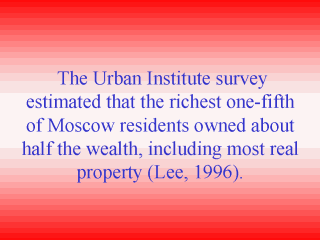 |
Only 18% of
Moscow households owned cars in 1992 and one-fourth owned a dacha, which increased to 35%
with cars and one-third with dachas in December, 1995. The highest income groups were also
most likely to exhibit the greatest mobility in acquiring housing units after 1992, and to
be least likely to experience overcrowding (less than 10%). In 1992, nearly 50% of lowest
income Moscow households were overcrowded. By 1995, this proportion decreased to
one-third, partially due to a shrinking population size, and splitting of extended
families into separate apartments. Almost 30% of municipal housing units and over 20% of
state employer-owned, departmental housing was privatized between 1992 and 1995.
Three-quarters of all privatized apartments in 1995 were owned by the non-pensioner,
white-collar, university educated in Moscow, who were also in the highest income groups
(Lee, 1996). |
